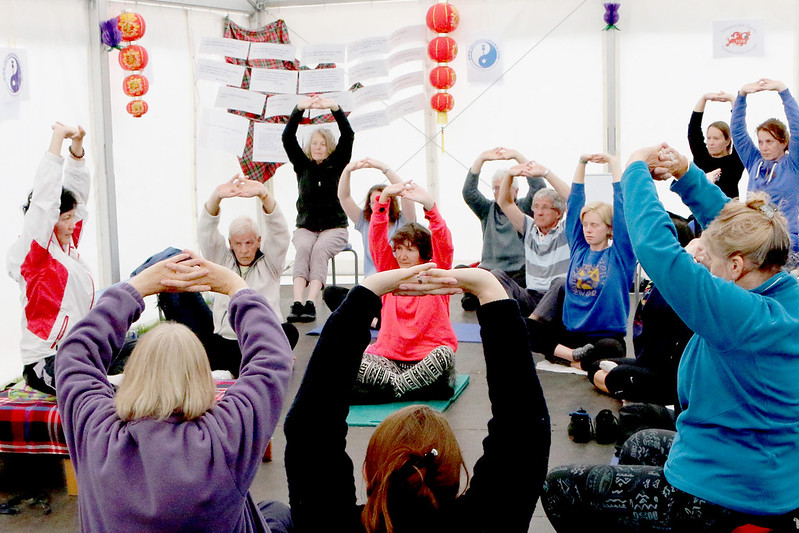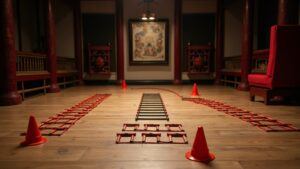
Qi Gong is often described as “meditation in motion.” Rooted in ancient Chinese medicine and martial arts, it’s a practice that harmonizes breath, gentle movement, and focused awareness. While many routines are performed standing, not everyone can—or wants to—be on their feet for extended periods. The beauty of Qi Gong is that its principles can be adapted into a seated routine that is just as powerful. Whether you’re working at a desk, recovering from injury, or simply prefer to practice in a chair, seated Qi Gong is a way to bring energy, relaxation, and vitality into your daily life.
This article will guide you through the benefits, principles, and a complete 20–30 minute seated Qi Gong routine you can practice anywhere.
Why Practice Seated Qi Gong?
- Accessibility
Seated Qi Gong removes barriers. People with mobility issues, balance concerns, or fatigue can still enjoy the benefits of Qi Gong without strain. - Convenience
You don’t need a yoga mat, open space, or even special clothing. A sturdy chair is all you need. - Energy Flow While Sitting
Even while seated, energy (qi) continues to flow through the body’s meridians. Gentle movements stimulate circulation, lubricate joints, and awaken the nervous system. - Stress Reduction
Breathing exercises combined with mindful motion soothe the sympathetic nervous system, making this routine an antidote to modern stress.
Core Principles to Remember
- Posture: Sit upright, feet flat on the ground, hands resting lightly on your thighs. Imagine a string gently pulling your crown toward the ceiling.
- Breath: Inhale through the nose, allowing the belly to expand. Exhale through the nose or mouth, softening the body.
- Intention: Direct your awareness to the movement and breath, letting thoughts drift away.
- Flow: Movements should feel smooth, circular, and unforced. Think of moving through water, not air.
The Seated Qi Gong Routine
This routine can be completed in 20–30 minutes. Each exercise can be practiced for 1–3 minutes.
1. Opening Breath and Grounding
- Sit with feet flat, spine tall.
- Place your hands on your lower belly.
- Inhale slowly, feeling the belly expand like a balloon.
- Exhale fully, gently drawing the navel toward the spine.
- Imagine roots growing from your feet into the earth.
Purpose: Connects you to your center, calms the mind, and begins energy circulation.
2. Neck and Shoulder Release
- Inhale and gently roll your shoulders upward.
- Exhale as you roll them down and back.
- Circle slowly, synchronizing with the breath.
- Next, tilt your head side-to-side, ear toward shoulder, breathing slowly.
Purpose: Releases tension that blocks energy flow to the head and heart.
3. Heaven and Earth Stretch (Seated Variation)
- Place your left hand palm-up just above your lap.
- Raise your right hand overhead, palm facing upward.
- Inhale as you stretch upward and downward simultaneously, as if separating heaven and earth.
- Exhale and switch sides.
Purpose: Opens the spine, balances energy between upper and lower body.
4. Cloud Hands
- Place both hands in front of your chest, palms facing each other as if holding a ball.
- Slowly move your right hand to the side, palm facing inward, while the left hand follows slightly lower.
- Shift your torso slightly as if moving through clouds.
- Continue side to side in a gentle, flowing motion.
Purpose: Promotes relaxation, clears mental fog, and improves coordination.
5. Waving the Bamboo
- Place your hands on your thighs.
- Gently sway the upper body side to side like bamboo in the wind.
- Keep the motion loose, letting the spine and ribs relax.
Purpose: Releases stiffness, massages internal organs, and softens tension in the torso.
6. Lotus Opening (Chest Expansion)
- Bring both hands to your chest, palms together.
- Inhale as you open the arms wide, palms turning outward, chest lifting slightly.
- Exhale as the hands return together in front of the chest.
- Imagine a lotus flower blooming with each breath.
Purpose: Expands the lungs, opens the heart, and improves posture.
7. Silk Reeling (Arm Circles)
- Extend your hands in front of you, palms facing down.
- Circle the wrists slowly outward, then inward.
- Allow the elbows and shoulders to follow, creating spirals of movement.
Purpose: Stimulates joint mobility, strengthens tendons, and enhances circulation.
8. Gathering Energy
- Place your hands at your sides.
- Inhale as you sweep your arms outward and upward, palms gathering energy.
- Exhale as you bring your hands down the centerline of your body, palms facing inward, as if showering yourself with qi.
Purpose: Recharges the body, clears stagnant energy, and cultivates vitality.
9. Abdominal Massage (Qi Cultivation)
- Place one hand over your navel, the other on top.
- Massage the belly in slow, gentle circles clockwise (12–24 times).
- Reverse the direction (12–24 times).
Purpose: Stimulates digestion, calms the nervous system, and strengthens the “dantian” (energy center).
10. Closing the Practice
- Rub your hands together until warm.
- Place palms over your eyes, absorbing the warmth.
- Slowly move hands down the face and rest them on the lap.
- Sit quietly for a few breaths, feeling gratitude for the practice.
Purpose: Seals in the energy, leaving you refreshed and centered.
Tips for Practice
- Consistency Matters More Than Duration: Even 10 minutes daily creates noticeable benefits.
- Stay Relaxed: If anything feels forced, ease up. Qi Gong is about flow, not strain.
- Visualize Energy: Imagine light or warmth moving through your body as you practice.
- Pair With Breath: Let breath lead the movement, not the other way around.
- Listen to Your Body: If you feel lightheaded, stop and return to grounding breaths.
Benefits You Can Expect
- Physical: Improved posture, reduced stiffness, stronger lungs, better digestion.
- Mental: Reduced stress, sharper focus, calm mind.
- Emotional: Greater patience, resilience, and inner peace.
- Spiritual: A sense of connection to life energy, awareness of your body’s rhythms.
Many practitioners notice better sleep, fewer aches, and more energy within weeks of consistent practice.
Seated Qi Gong and Modern Life
We live in a world where people spend countless hours sitting—at desks, in cars, on couches. While sitting has been branded as “the new smoking,” Qi Gong provides a solution. Instead of letting sitting damage the body, you can transform your chair into a training ground for health and energy.
Imagine replacing five minutes of scrolling social media with five minutes of Cloud Hands. Or starting your day not with coffee, but with Gathering Energy. These small swaps add up to big shifts in vitality.
Final Thoughts
The beauty of Qi Gong is its adaptability. Standing or seated, young or old, fit or fatigued—it meets you where you are. A seated Qi Gong routine offers all the essential elements of the art: breath, movement, stillness, and awareness.
So, the next time you find yourself stuck in a chair, remember: you don’t have to be still, stiff, or stressed. You can flow, breathe, and cultivate energy right where you are.
Take a seat, breathe deeply, and let the qi move.





